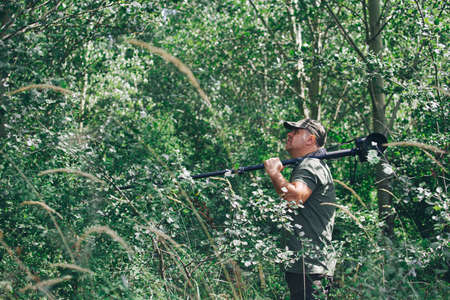1. Mastering the Fundamentals of Competitive Casting
Before you can fine-tune your casting for tournaments, it’s essential to nail down the basics. Competitive casting is all about accuracy, distance, and speed — but none of those matter without a solid foundation. Let’s break down the key elements that every serious angler needs to master: grip, stance, rod action, and reel coordination.
Grip: Finding Control and Comfort
Your grip affects everything from power to precision. Most anglers use either the thumb-over or finger-trigger grip depending on their rod and reel setup. The goal is control — not squeezing too tight or holding too loose. A relaxed, firm grip allows for better wrist movement and smoother casts.
| Grip Type | Best For | Key Advantage |
|---|---|---|
| Thumb-Over Grip | Baitcasting reels | Greater control during release |
| Finger-Trigger Grip | Spinning reels | Improved line management |
Stance: Building a Stable Launch Platform
Your stance should give you balance and leverage. Think athletic — feet shoulder-width apart, knees slightly bent. Right-handed casters usually place their left foot forward for better weight transfer during the cast. This helps generate both distance and accuracy.
Quick Tip:
If youre casting into wind or across current, adjust your stance angle to maintain balance and maximize rod efficiency.
Rod Action: Timing Your Power
The action of your rod — how much it bends and where — plays a huge role in casting performance. Fast-action rods bend near the tip and offer quick snapback, ideal for long-distance or pinpoint casts. Moderate-action rods flex more through the blank, which helps when casting lighter lures or needing more forgiveness.
| Rod Action | Bend Location | Ideal For |
|---|---|---|
| Fast Action | Top third of the rod | Long casts and heavy lures |
| Moderate Action | Middle section of the rod | Lighter lures and better control |
Reel Coordination: Timing Is Everything
A great cast isn’t just about strength — it’s about timing between your hand motion and reel release. With spinning reels, open the bail at just the right moment in your swing; with baitcasters, use your thumb to feather the spool for controlled release and minimal backlash. Practicing this coordination builds muscle memory, which is key under pressure.
Pro Insight:
In competitive scenarios, seconds count. Developing smooth reel handling lets you reset quicker after each cast — giving you more chances to hit your target zone.
Nailing these fundamentals will set you up for success as we move into more advanced techniques in future sections.
Techniques for Boosting Casting Distance
When youre fishing competitively, every extra foot of casting distance can give you a big edge. Whether youre trying to reach schooling bass on the far side of a weed bed or covering more water in open flats, increasing your casting range is key. Lets break down a few advanced techniques that serious tournament anglers use to get the most out of every cast.
Double-Hauling
Originally popularized in fly fishing, double-hauling is a technique that can also be adapted for spinning and baitcasting setups. It involves using both hands to add extra speed to your line during the cast. Your dominant hand controls the rod while your other hand pulls on the line or spool at just the right moment to increase line speed and distance. This move takes some timing and practice, but once you’ve got it down, youll notice a serious bump in how far you can throw.
Pendulum Casting
This technique is especially useful when using surf rods or long-distance setups. The pendulum cast uses a swinging motion—similar to a golf swing—to generate momentum before release. Start with your lure behind you, swing it forward in an arc, and release at the optimal point for maximum lift and carry. It’s all about rhythm, balance, and timing.
Pendulum Casting Tips:
- Use your whole body, not just your arms
- Practice on flat ground before trying it near water
- Watch your release angle—aim for about 45 degrees for max distance
Selecting the Right Rod
Your rod plays a huge role in how far you can cast. Different rods are built with different actions, lengths, and power ratings—all of which affect casting performance. In tournaments where distance matters, choosing the right rod can make or break your day.
Rod Selection Guide for Distance Casting
| Rod Length | Action | Best For |
|---|---|---|
| 76″ – 9 | Fast to Extra Fast | Bass fishing in open water |
| 10 – 13 | Moderate to Fast | Surfcasting or long-range lake casting |
| 7 – 8 | Moderate Fast | Tournament finesse setups with light lures |
Tuning Your Gear
Your reel settings can also influence how much line you’re able to send flying. On baitcasters, adjust your brake system and spool tension so the lure drops smoothly without backlash. With spinning gear, make sure your spool is filled properly—too little line reduces distance; too much causes wind knots.
Baitcaster Setup Tips:
- Tune magnetic or centrifugal brakes based on lure weight and wind conditions
- Add high-performance bearings for smoother casts
The combination of proper technique, smart equipment choices, and fine-tuned gear will help you maximize your casting distance under tournament pressure. Each method takes time to master—but once you do, youll have a real advantage over less-prepared competitors.
![]()
3. Pinpoint Accuracy Under Pressure
In competitive fishing, its not just about casting far—its about hitting the exact spot, especially when time is ticking and the pressure is on. Whether youre trying to land your lure inches from a dock post or thread it between overhanging branches, pinpoint accuracy can be the difference between placing in a tournament or going home empty-handed.
Mastering Fast and Accurate Successive Casts
During competitions, youll often need to make multiple casts in quick succession without sacrificing accuracy. Here are a few techniques to help:
- Muscle Memory: Practice consistent casting motions to build automaticity.
- Pre-Set Targets: Visualize specific targets before each cast to stay focused.
- Minimal Repositioning: Reduce unnecessary movements between casts to save time and improve control.
Adjusting for Wind and Current
Environmental factors like wind and current can quickly throw off even the most practiced angler. Heres how to compensate:
| Condition | Adjustment Tip |
|---|---|
| Strong Headwind | Use a lower trajectory and heavier lure to cut through the wind. |
| Crosswind | Aim slightly upwind of your target; let the wind carry your lure into position. |
| Current Pulling Lure Off-Target | Cast upstream or up-current to allow drift correction during descent. |
Nailing Tight Spots with Precision
Tight cover like docks, laydowns, or vegetation edges require finesse and confidence. Try these tips:
- Skip Casting: Perfect for getting under low-hanging obstacles. Practice skipping lures like skipping stones across water.
- Pendulum Casts: Use underhand or sidearm casts with short rods for better control in tight quarters.
- Sight Alignment: Line up your rod tip directly with the target before making your move—just like aiming a rifle.
Tournament Tip:
Use high-visibility lines during practice sessions so you can visually track your cast path and make micro-adjustments as needed. Switch back to low-vis line during actual tournaments for stealth.
Pro Insight:
“In a high-stakes tournament, I treat every cast like it’s my only shot. Focus, breathe, and trust your training.” — Jake Thompson, Bassmaster Elite Series Angler
The more you train under simulated pressure—with timers, obstacles, and variable conditions—the more natural accurate casting becomes when it counts most.
4. Increasing Casting Speed and Efficiency
When youre fishing competitively, every second counts. The faster and more consistently you can cast, the more opportunities you have to present your bait in the strike zone. Improving your casting speed doesnt mean rushing—it means refining your technique so that each movement is smooth, efficient, and repeatable under pressure.
Eliminate Unnecessary Motion
One of the first steps to increasing casting speed is cutting out extra movements. Over time, anglers often develop habits that slow them down—like excessive rod loading, big wind-ups, or hesitating before releasing the line. Identify these habits by recording your casts or having a coach observe you. Focus on making each part of the cast serve a purpose.
Common Inefficient Movements and Fixes
| Inefficient Movement | How to Improve |
|---|---|
| Over-extended backswing | Shorten backcast to load rod quicker |
| Double-checking line before release | Practice confident releases with muscle memory drills |
| Unnecessary wrist flicks | Keep wrist stable and use forearm for control |
Refine Your Timing
Casting isnt just about strength—its about timing. A well-timed cast uses the rods natural flex (or “load”) to generate maximum power with minimal effort. Practice feeling the load point of your rod and releasing at just the right moment. This improves both distance and speed without tiring you out.
Timing Drill:
Try this: Use a metronome app set to a moderate beat. Cast in rhythm with the beat, focusing on smooth transitions from backcast to forward cast. This builds consistency and control in your timing.
Build Muscle Memory Through Repetition
The best competitive anglers make fast casts look effortless because their muscles already know what to do. To reach that level, repetition is key. Practice short casting sessions daily rather than long sessions once a week. This helps your brain and body lock in the motion.
Muscle Memory Building Plan (Weekly)
| Day | Focus Area | Drill Duration |
|---|---|---|
| Monday | Accuracy casting at targets | 20 minutes |
| Wednesday | Speed casting with stopwatch | 15 minutes |
| Friday | Smooth rhythm and timing drills | 20 minutes |
Mental Preparedness for High-Pressure Moments
A big part of casting efficiently during tournaments is staying calm and focused. When adrenaline kicks in, its easy to overcast or lose rhythm. Practice under simulated pressure—use timers, compete with friends, or set goals for number of accurate casts in a row. Getting used to these conditions will help you stay sharp when it matters most.
The more streamlined your movements are, the more consistent and quick your casts will become—giving you an edge in any competitive angling scenario.
5. Tools, Tuning, and Tactics from the Pros
When it comes to competitive angling, having top-tier casting skills is just part of the game. What truly separates the weekend warrior from a tournament-level angler is how well they tune their gear and adopt habits that maximize performance under pressure. Let’s break down how pros optimize their tackle, customize their setups, and develop winning routines.
Optimizing Your Tackle Setup
Your gear should be dialed in for the type of casting you’re doing—whether it’s long-distance bombing or pinpoint skipping under docks. Matching your rod, reel, and line to each other is key. Here’s a simple breakdown:
| Rod Type | Reel Choice | Line Type | Best Use |
|---|---|---|---|
| 76″ Medium-Heavy Fast Action | Baitcaster (High Gear Ratio) | Fluorocarbon 15-20 lb | Long-distance casting with jigs or soft plastics |
| 610″ Medium Light Extra Fast | Spinning Reel (3000 size) | Braided Line with Fluoro Leader | Finesse presentations & accuracy casting |
| 72″ Heavy Moderate Fast | Baitcaster (Low Gear Ratio) | Braided Line 50-65 lb | Frog fishing or heavy cover flipping |
Customizing Gear for Performance
Pros often make small adjustments that add up to big gains on the water. These include:
- Tuning Reels: Adjusting brake systems and spool tension helps control backlash while maximizing distance and speed.
- Aftermarket Handles: Upgraded handles offer better grip and quicker retrieves during rapid-fire casts.
- Ceramic Bearings: Swapping out stock bearings can increase casting smoothness and distance.
- Lighter Components: Using lightweight rods and reels reduces fatigue over a long tournament day.
Tournament-Proven Habits
The best anglers dont just rely on gear—they develop habits that enhance every cast. Here are some tactics used by top-tier pros:
Mental Preparation & Routine
Tournament anglers practice casting daily, often setting up backyard targets to build muscle memory and consistency. They also mentally rehearse scenarios to stay sharp under pressure.
Tactical Positioning
Knowing where to stand on the boat or how to angle your body before a cast can improve both distance and accuracy—especially when time is tight or wind conditions are tricky.
Efficiency Drills
A fast setup-to-cast cycle means more water covered. Pros practice re-rigging quickly and keeping tools like scissors or scent sprays within reach at all times.
The Pro Edge: Combining All Elements
The real edge comes from integrating tuned-up gear with laser-focused habits. Competitive anglers don’t just cast—they calculate every move. By customizing your tools, refining your technique, and adopting efficient on-the-water strategies, you’ll be better prepared to perform when it counts most.


